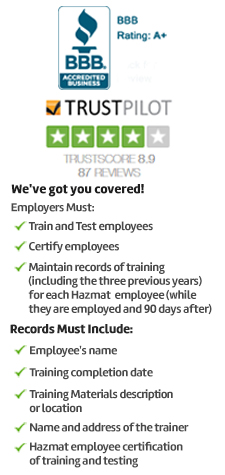
Cal/OSHA Training Certification

The aim of this online course is to help learners aware of the atmospheric hazards present in the workplaces and how to protect workers from them. The course also trains candidates on how to select the right kind of respirator in a workplace, how to fix the respirator properly, how to clean the respirator and keep it disinfected and how to analyze the work atmosphere and take necessary action to protect the health of workers. During the training, the participants will also get an overview of the California general-industry respiratory protection standard.
Governing regulations
Offered through e-learning mode, this course fulfils the training regulations as mentioned in Cal/OSHA Title 8 CCR, Section 5144 Respiratory Protection Safety Standard.
Course Overview
Respiratory hazards, which present in various work environments, can be dangerous and sometimes be fatal. Dangerous pollutants in the air can cause severe respiratory problems and asthma and dust particles and poisonous gas, which can be odorless, can be unsafe. Though there are quite a few incidents of injuries and fatalities due to respiratory hazards in work environments, there are some regulations which have been made to prevent workers from such hazards. This course precisely addresses the kinds of hazards workers have to deal with and safety measures to reduce the risks and overexposure. This course also deals with applicable legislations and laws for both employers and workers and compliant procedures. The training includes the propagation of details pertaining to the California standards with respect to occupational respiratory risks and protection standards.
Who Must Take this Course?
It is the responsibility of the employers to keep the workplace clean and healthy following all necessary protocols. Workers who are exposed to highly dangerous atmosphere where they stand to get exposed to unhealthy air should join this course. Employers should also ensure that all workers are adequately informed about the possible atmospheric hazards and the health implications in case of accidental exposure. Apart from understanding the nature of hazards which depends on industries, workers should also undergo regular review of their knowledge and expertise to deal with workplace hazards and upgrade their skills and knowledge on new risks and hazards, improved protective equipments such as ventilators and effective preventive measures. As usage of respirators has been strictly regularized, employers who seek to use respirators for their workers must have a written respiratory protection program.
Course Format
Our Cal/OSHA Respiratory Protection Safety Training course complies with all standard training procedures for its effectiveness. Students seeking to join this course are provided with excellent course material with easy to comprehend graphical and audio presentations and a well-researched question bank for self check which can give them a better preparation before the final exam.
Upon successful completion of the course, each student will get a hard copy of completion certificate and can print a wallet card.
Continuing education credits?
Each student will receive 0.2 CEUs (or 2 CMEs) from Compliance Training Online® for completing this course.
Topics Covered
- About This Course
- Course Objectives
- Introduction to Respiratory Safety Training
- Key Terms
- Respiratory Hazards
- Affected Industries
- Lung Diseases
- Applicable Regulations
- Respiratory Protection Program
- The Respiratory Protection Program
- Training
- Program Evaluation
- Recordkeeping
- Voluntary Respirator Use
- Respirator Selection
- Assigned Protection Factor and Maximum Use Concentration
- Assigned Protection Factors for Different Types of Respirators
- Facial Attachments-Tight-Fitting Coverings
- Facial Attachments-Loose-Fitting Coverings
- Air-Purifying Respirators
- Powered Air-Purifying Respirators
- Supplied-Air Respirators
- Self-Contained Breathing Apparatus
- Specific Uses
- Respirators for IDLH situations
- Fit Testing
- When to Use Fit Testing
- User Seal Check
- Qualitative and Quantitative Fit Testing
- Qualitative Fit Testing
- Quantitative Fit Testing
- Use and Maintenance
- Facepiece Seal Protection
- Continuing Respirator Effectiveness
- Procedures for IDLH Atmospheres
- Cleaning and Disinfecting Respirators
- Cleaning and Disinfecting Procedures
- Storage and Repairs
- Inspections
- Air Quality Control
- Compressed Breathing Air Cylinders
- Other Quality Measures
- Medical Evaluations
- Medical Evaluation Procedures
- Information for the Physician or Health Care Provider
- Evaluation Results
- Summary
- Additional Resources
- Exam

 NEBOSH CERTIFICATE
NEBOSH CERTIFICATE NEBOSH DIPLOMA
NEBOSH DIPLOMA IOSH
IOSH SAFETY DIPLOMA
SAFETY DIPLOMA CPD UK
CPD UK ROSPA UK
ROSPA UK FOOD SAFETY
FOOD SAFETY 



